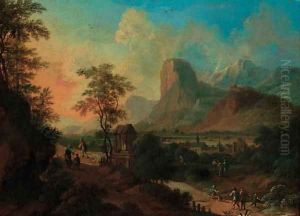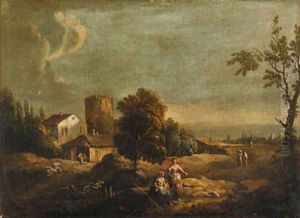Frans De Paula Ferg Paintings
Frans de Paula Ferg, also known as Franz de Paula Ferg or simply Ferg, was an Austrian painter born in Vienna in 1689. He was part of a family of painters, with his father, Paul Ferg, being an established landscape and vedute artist. This early exposure to art, along with the artistic environment of his hometown, undoubtedly influenced Ferg's decision to pursue a career in the arts.
Ferg showed considerable talent from a young age, and his father was his first teacher. He later traveled to paint and study, which was common for artists of his time. His journeys took him to places like Germany and London, where he expanded his skills and was exposed to a variety of art forms and techniques. These experiences enriched his style and contributed to his versatility as an artist.
Best known for his small-scale cabinet paintings, Ferg specialized in landscapes, genre scenes, and vedutas, which are detailed paintings of cityscapes. His work is characterized by its fine brushwork and the charming and lively depiction of figures within the landscape. Ferg was skilled at capturing the atmosphere of the environments he painted, whether it was the hustle and bustle of urban life or the serene beauty of the countryside.
Throughout his career, Ferg's paintings were sought after by collectors and art lovers. His ability to depict scenes with accuracy and emotion made him a popular artist during his lifetime. However, despite his success, he faced financial difficulties, which were not uncommon for artists of the period.
Ferg's legacy is reflected in his influence on the genre of landscape painting in the 18th century. Though he may not be as widely known as some of his contemporaries, his work has been recognized for its contribution to the development of the Rococo style in painting. Ferg's paintings can be found in various museums and private collections around the world, offering a glimpse into the life and scenery of the 18th century.
Frans de Paula Ferg died in London in 1740, leaving behind a body of work that continues to be appreciated by art historians and enthusiasts alike. His paintings serve as a testament to his skill and the artistic vibrancy of the period in which he lived.

